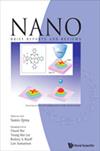Synthesis and Characterization of Multistage Porous Sodalite Nanocrystal Aggregate
IF 1
4区 材料科学
Q4 MATERIALS SCIENCE, MULTIDISCIPLINARY
引用次数: 0
Abstract
Using the mixed solution of [Formula: see text]-butanol and ethanol as solvent, the sodalite nanocrystal aggregate was prepared by the solvothermal method. The influences of crystallization temperature, molar ratio Na/Al, crystallization time and silane concentration on the morphology, crystallite size, degree of crystallization and pore structure of the as-prepared samples were investigated by X-ray diffraction (XRD), BET, FTIR, Transmission Electron Microscopy (TEM) and scanning electron microscope (SEM). The results reveal that the sodalite nanocrystals are aggregated by self-assembly into the micropore–mesopore–macropore structure. Higher crystallization temperature and longer crystallization time are conducive to the growth of sodalite nanocrystals. It is a necessary condition for the formation of sodalite nanocrystals to keep high molar ratio Na/Al. The higher the molar ratio Na/Al, the more favorable the crystallization of sodalite nanocrystals. The appropriate concentration of silane agent is conducive to the preparation of smaller crystal-sized sodalite nanocrystals. After removing the silane agent by pickling, the sodalite nanocrystal aggregate is a multistage porous structure with the pore volume of 1.0133[Formula: see text]mL/g and the specific surface area of 449.73[Formula: see text]m 2 /g.多级多孔钠石纳米晶聚集体的合成与表征
以[公式:见文]-丁醇和乙醇的混合溶液为溶剂,采用溶剂热法制备了钠石纳米晶聚集体。采用x射线衍射(XRD)、BET、FTIR、透射电子显微镜(TEM)和扫描电子显微镜(SEM)研究了结晶温度、Na/Al摩尔比、结晶时间和硅烷浓度对制备样品形貌、晶粒大小、结晶程度和孔隙结构的影响。结果表明,钠盐纳米晶体通过自组装聚集成微孔-中孔-大孔结构。较高的结晶温度和较长的结晶时间有利于钠石纳米晶的生长。保持较高的Na/Al摩尔比是钠盐纳米晶形成的必要条件。Na/Al摩尔比越高,越有利于钠盐纳米晶的结晶。适当浓度的硅烷剂有利于制备更小晶体尺寸的钠石纳米晶体。酸洗去除硅烷剂后,钠盐纳米晶团聚体为多级多孔结构,孔隙体积为1.0133[公式:见文]mL/g,比表面积为449.73[公式:见文]m2 /g。
本文章由计算机程序翻译,如有差异,请以英文原文为准。
求助全文
约1分钟内获得全文
求助全文
来源期刊

Nano
工程技术-材料科学:综合
CiteScore
2.10
自引率
0.00%
发文量
95
审稿时长
1.6 months
期刊介绍:
NANO is an international peer-reviewed monthly journal for nanoscience and nanotechnology that presents forefront fundamental research and new emerging topics. It features timely scientific reports of new results and technical breakthroughs and also contains interesting review articles about recent hot issues.
NANO provides an ideal forum for presenting original reports of theoretical and experimental nanoscience and nanotechnology research. Research areas of interest include: nanomaterials including nano-related biomaterials, new phenomena and newly developed characterization tools, fabrication methods including by self-assembly, device applications, and numerical simulation, modeling, and theory. However, in light of the current stage development of nanoscience, manuscripts on numerical simulation, modeling, and/or theory only without experimental evidences are considered as not pertinent to the scope of NANO.
 求助内容:
求助内容: 应助结果提醒方式:
应助结果提醒方式:


